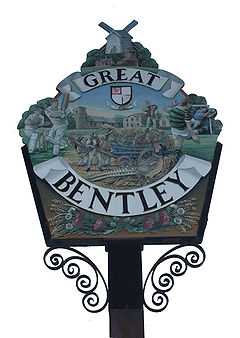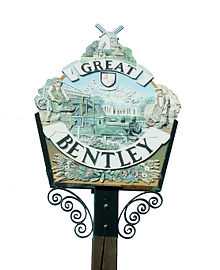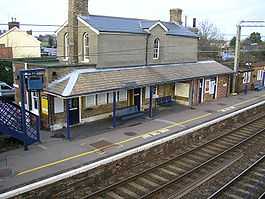Great Bentley
| Great Bentley | |
 The village sign |
|
 Great Bentley |
|
| Population | 2,381 (Tendring 009C LSOA) |
|---|---|
| OS grid reference | TM110215 |
| District | Tendring |
| Shire county | Essex |
| Region | East |
| Country | England |
| Sovereign state | United Kingdom |
| Post town | Colchester |
| Postcode district | CO7 |
| Dialling code | 01206 |
| Police | Essex |
| Fire | Essex |
| Ambulance | East of England |
| EU Parliament | East of England |
| UK Parliament | Harwich and North Essex |
| Website | greatbentleyparishcouncil.co.uk |
Coordinates: 51°51′08″N 1°03′53″E / 51.8521°N 1.0648°E
Great Bentley is a village and civil parish in the Tendring district of North Essex, England, located seven miles east of Colchester. It is home to the largest village green in the country, at a size of 43 acres (170,000 m2) and has won 'Village of the Year' several times. Great Bentley railway station provides the village with frequent rail services along the Sunshine Coast Line to London Liverpool Street, Clacton-on-Sea, Colchester and Walton-on-the-Naze.
Great Bentley is scattered round an extensive level or common, of 43 acres (170,000 m2), on the eastern side of the vale of a rivulet, seven miles (11 km) east-south-east of Colchester. The parish contains 2500 inhabitants, and 3,188 acres (13 km²) of fertile land, including hills and valleys, and extending southward to the Flag Creek, a tidal creek which connects with the Colne, near Brightlingsea. Pubs in the area include The Plough Inn beside the village green and the Royal Fusilier in Aingers Green. The village has yet again retained the title for 'Best Kept Village in Essex', winning in both 2009 and 2010.
Great Bentley is the second largest village in the Tendring district, with a population of 2,381. The village has road, rail and bus links.
Contenders for the title of largest village green in England include West Auckland and Old Buckenham. Frampton on Severn has also been cited, but at 22 acres (89,000 m2) it does not even match Great Bentley.
History
The village is mentioned as far back as the Domesday Book and at that time it was situated amongst large wooded areas. The clearing of these woods began in 1135. In its early days the village was named Benetlea, then Much Bentley and later still Great Bentley. The first part of the name, Bent, is thought to refer to a type of grass, and the later part, lea, probably derives from the word ley, meaning land sown with grass, which suggests a direct reference to the green. Great Bentley did have a port at Flag Creek which was used to import and export goods. Queen Elizabeth I once visited Lord Darcy’s residence, St Osyth Priory. It is believed she may have arrived at Harwich accompanied by her courtiers and rode via Horsley Cross, Little Bentley then onto Great Bentley Green before finishing her journey to St Osyth. Great Bentley owes much of its growth to the coming of the railway in 1866, with the railway station being named Bentley Green before being changed to its present title of Great Bentley in 1877.
Two new housing estates were built in the 1960s on either side of the Village Green. This was followed by a trading estate being developed close to the railway station, now known as the Plough Road Business Centre. At that time the village boasted five public houses, Post Office, a Garage, several small retail shops and businesses, a School and a Doctor’s surgery. All of these amenities remain to this day, except for three of the public houses which have since closed down. Also in the 1960s Great Bentley Parish Council, on behalf of the village, purchased the manorial rights of the 42.5 acres (172,000 m2) of Common Land. Much of the purchase price was raised through voluntary donations from the residents and fund raising events. The land was then registered as village green to protect the green for the future from encroachment and erosion. The Village Green and nearby properties are a Conservation Area. The Parish Council, through the Common Land and Village Green Acts, ensures the protection of the Village Green.
Great Bentley Primary School
Great Bentley School was built in 1896 and its front façade is a good example of a school built in the late Victorian era. The school retains many of its original features including wooden parquet flooring and high ceilings in the original part of the building. Several extensions have been added to the school over the years, and the most recent was completed in 2003. In the year 2000 a clock was added to the centre of the original building in commemoration of the new millennium. The school currently has 210 pupils aged between 4 and 11 years. The school is maintained by Essex County Council, and is now called Great Bentley County Primary School. The school's catchment area includes the nearby villages of Thorrington, Frating, Aingers Green and Little Bentley. The 2014 Ofsted report gave several reasons why the school was not good. [1]
Great Bentley Football Club
Great Bentley Football Club was founded between 1895 and 1896, and its original headquarters were the Victory Inn public house (now a hair salon) in Great Bentley. The club now has its own clubhouse and dressing rooms built on the site of an old World War II Nissen hut in 1959. In 2009, new dressing room and bar facilities were completed to replace this, costing £220,000. The new facilities were officially opened by Lord John Bassam of Brighton who used to play for the club. The club has three senior teams; two of these play in the Essex and Suffolk Border Football League, and the other in the Colchester and East Essex Football League. On 8 August 2009, a friendly was played against Colchester United on the Village Green as part of the grand opening of the new dressing rooms and bar.
Village green

The village green covers some 43 acres (170,000 m2) and is reputed to be one of the largest in England. The village green was the site of a steam mill which was built in 1886. The mill chimney was demolished in 1925, and what remains of the structure today has been converted into apartments. Adjacent to the mill was a large pond which no longer exists, and a handful of willow trees mark the spot. To the north of the mill is a children's play area and a small nature reserve containing various species of grasses that can only be found in the local area. To the east of this is the old mill house where a windmill once stood within the walled gardens of the house, but this was also demolished in the late 19th century. The green has long been used for various recreational and sporting events. In Edwardian times, it was used as a golf course, and today the local cricket and football teams can often be seen playing matches. During the last weekend of August,the green has provided the venue for Great Bentley Village Carnival and Fete every year since 1974. In recent years, the Green has also become popular with motorcyclists from around the country. During the summer months, the Green becomes the site of a mini motorcycle rally on Wednesday evenings. This can be quite an impressive spectacle as on some occasions there have been over 1,000 motorcycles there.


Location
 |
Frating | Little Bentley | Tendring |  |
| Alresford | |
Weeley | ||
| ||||
| | ||||
| Thorrington | Aingers Green | Little Clacton |
Notable residents
- Lord Bassam, the Opposition Chief Whip in the House of Lords, grew up in the village and attended the local primary school.
- John Sydenham Furnivall, a former Cambridge University scholar and later British colonial administrator to Burma, was born in the village.
- Maud de Ufford, Countess of Essex, who was arrested and later pardoned for conspiring against King Henry IV of England in 1404.
- Jeremy Spake, famous for his role in BBC's Airport, resides in the village.
- Michael Steele, involved in the 1995 Rettendon murders, of which he and accomplice Jack Whomes were found guilty of murder in 1998 at the Old Bailey. The murders were used as the basis for the 2000 film Essex Boys, and 2007 film Rise of the Footsoldier. Both men have always protested their innocence.
Public houses
Until the 1980s Great Bentley had five public houses. These were the Red Lion (now used as offices), the Victory Inn (now a hair salon), Dusty's Wine Bar (now the pharmacy), The Plough Inn and The Royal Fusilier at Aingers Green. Only the The Plough Inn and The Royal Fusilier are still in business today.
Transport

Road
- The A133 road runs through the north of the village and provides access to Colchester and Clacton-on-Sea, and onwards via the A120 and A12 to Chelmsford and London.
- The B1027 road links the village to Colchester and Clacton-on-Sea via St Osyth.
- The B1029 road links the village to Brightlingsea and Dedham.
Bus
Bus services to Colchester and neighbouring communities are provided by New Horizon Travel.
Rail
Great Bentley railway station is located on the Sunshine Coast Line, a branch of the Great Eastern Main Line. The village is served by local services to Colchester and Walton-on-the-Naze during off-peak hours as well as express services to London Liverpool Street and Clacton-on-Sea during peak hours. All services are operated by Abellio Greater Anglia.
The Sunshine Coast Line reached Great Bentley in 1866 and has contributed greatly towards the growth of the village ever since, effectively making Great Bentley a commuter village. It was the only form of public transport in the village from 1866 up until 2010 - the year in which a new local bus service to Colchester was launched, which may explain the high patronage for a village station. The station is used by commuters from within the village and from neighboring towns and villages such as Brightlingsea, Frating, St Osyth and Thorrington.
Climate
| Climate data for Great Bentley | |||||||||||||
|---|---|---|---|---|---|---|---|---|---|---|---|---|---|
| Month | Jan | Feb | Mar | Apr | May | Jun | Jul | Aug | Sep | Oct | Nov | Dec | Year |
| Average high °C (°F) | 6 (43) |
7 (44) |
9 (49) |
12 (54) |
16 (61) |
19 (66) |
22 (71) |
22 (71) |
18 (65) |
14 (57) |
9 (49) |
7 (44) |
14 (57) |
| Average low °C (°F) | 2 (35) |
2 (35) |
3 (37) |
4 (39) |
7 (45) |
10 (50) |
12 (54) |
12 (54) |
11 (51) |
8 (46) |
4 (40) |
3 (37) |
7 (44) |
| Average precipitation mm (inches) | 37 (1.46) |
31 (1.22) |
29 (1.14) |
34 (1.34) |
32 (1.26) |
41 (1.61) |
41 (1.61) |
38 (1.5) |
41 (1.61) |
48 (1.89) |
44 (1.73) |
39 (1.54) |
455 (17.91) |
| Source: MSN Weather | |||||||||||||
Saint Mary's Church
The church of St Mary the Virgin dates back to the 11th century, and was built by the Normans. The tower was added some 200 years later, and has recently undergone a £100,000 restoration project. The church itself is constructed from stone and flint, and still has its original door (the oldest surviving church door in the country), although it is no longer in use.
References
- Essex & South Suffolk Community Rail Partnership
External links
- Great Bentley Parish Council
- Great Bentley entry in Post Office Directory of Essex, Herts, Kent, Middlesex, Surrey and Sussex, London: Kelly, 1855
| Wikimedia Commons has media related to Great Bentley. |